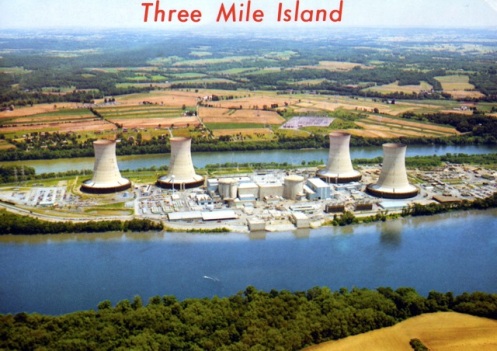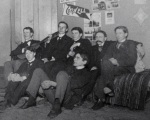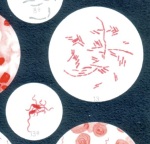How “The Epidemic” came to be

Marshall Dussinger aerial photo of Three Mile Island nuclear plants, looking east.
I have been working on The Epidemic for a long time.
In 1989, I became interested in the Three Mile Island nuclear accident. As a reporter for The Patriot-News in Harrisburg, Pa., I wrote a recreation of the accident for our coverage of the accident’s tenth anniversary. The TMI Unit 2 meltdown occurred in 1979 about ten miles south of where I live in Harrisburg. Even today, I can look out my third floor window and see the plume of steam rising from the undamaged Unit 1 reactor. It was and is a dramatic, compelling story–no catastrophe in which a hundred thousand people flee their homes can be otherwise–and I decided to write a book about it.
Fate intervened in the form of an angry TMI owner, the company then known as General Public Utilities Corp., or GPU. I nearly lost my job–thanks to the Newspaper Guild for saving it–and discovered that the publishing world thought there were enough books about TMI already. I disagreed, but needed to find a different angle to pursue. Reader’s Guide–remember that?–led me to a 1946 article about GPU. I believe it was in Business Week.
That article was the first I found that mentioned the early history of GPU, when it was called Associated Gas & Electric Co. and run by John I. Mange and Howard C. Hopson. Hopson was the real power. He was an early utility regulator in New York State who had gone over to the dark side. Associated Gas & Electric was a huge criminal enterprise. It owned local utilities in more than half the states, including Pennsylvania, as well as in Canada and the Philippines. Hopson and President Franklin D. Roosevelt engaged in a dance of death that lasted until Hopson was indicted and imprisoned in 1940. He was already insane from tertiary syphilis by that time, and spent most of his confinement in the Federal Prison Hospital in Springfield, Mo. Hopson was a major white collar criminal, responsible for tens of thousands of average Americans losing their life savings or being ripped off at the electric meter. Associated Gas & Electric went into receivership, was worked over by the Securities and Exchange Commission, and emerged in 1946, much smaller, as GPU. I had my angle. I would write a history of GPU that included TMI but also included Hopson.
In 1993, I was doing research on Associated Gas & Electric at the New York Public Service Commission in Albany, N.Y. The commission is headquartered in one of those futuristic office towers (a.k.a., the Empire State Plaza) built by Gov. Nelson Rockefeller that look like they should be a city in a Star Trek movie. In one of the documents I viewed on microfilm was a footnote that referred to a typhoid epidemic in Ithaca, N.Y., where I knew Associated Gas & Electric had originated. That was how I discovered GPU had an even earlier history. My book changed again. I began researching how William T. Morris, aided by his Ithaca friends from the city’s elite families, especially the Treman family, took over Ithaca Water Works. Cornell University financed an important part of the deal, and in so doing killed 29 of its own students after a dam built by Morris yielded not water, but typhoid.
About twelve years into this project, I realized that one book on GPU would either be too large and unwieldy or would end up being cut drastically. So I decided to write three books: one on Ithaca, one on Hopson, and one on GPU’s nuclear misadventures that led to Three Mile Island. My only regret in doing this is that it will make it harder to tell the compelling story of Associated Gas & Electric’s American employees at Manila Electric Co., who saw their tropical paradise turn into horror when the Japanese conquered the Philippines in 1942. They and their wives and children were held by the Japanese Army in camps, mostly in the Santo Tomas camp, under increasingly brutal conditions until American soldiers rescued them in 1945. It’s a hell of a story, and I interviewed many of the survivors.
All of the research for Hopson is done, and most of that for TMI. I think I have enough years left in me to finish them all, but I can only hope. There are other books I want to do, too, including the one I am working on now, about the murder in 1969 of Betsy Aardsma, a Penn State graduate student from my hometown of Holland, Michigan, who was stabbed to death in the university library. Her killer fled into the night, was never caught, and is now dead. I have a pretty good idea who he was.
I am sure there are any number of people who thought I would never complete any part of this GPU project. I may have been one of them from time to time. But I stayed with it because the research was fascinating, a voyage through the dark intercourse between a major American corporation and the people of America. I still find it amazing that one corporation could have the Ithaca typhoid epidemic, the crimes of Howard Hopson, and the Three Mile Island nuclear accident in its long and tortured history, yet survive for a hundred years. I think only a regulated utility with its captive customers and guaranteed rate of return could have pulled that off. Enron’s crimes were equally ambitious, but it lacked those backstops and so disappeared when the final reckoning came.
- Cornell students at Potter’s Falls, ca. 1903. M. Paula Geiss Scrapbook, Cornell University RMC
- Birds eye view of Cornell campus, ca. 1903. The Rotograph Co.
- Cornell students, ca 1903. Hulbard Papers, Cornell University Rare & Manuscript Collections.
- View of Early 20th century Ithaca. Hugh C. Leighton Co.
- Newspaper advertisement during 1903 typhoid epidemic in Ithaca
- Cornell students in front of Sage College, the dormitory for women, ca. 1903. M. Paula Geiss Scrapbook, Cornell University RMC
- Typhoid bacilli, upper right, and in close-up, lower left. Leipzig: Bibliographisches Institut, 1902-08








